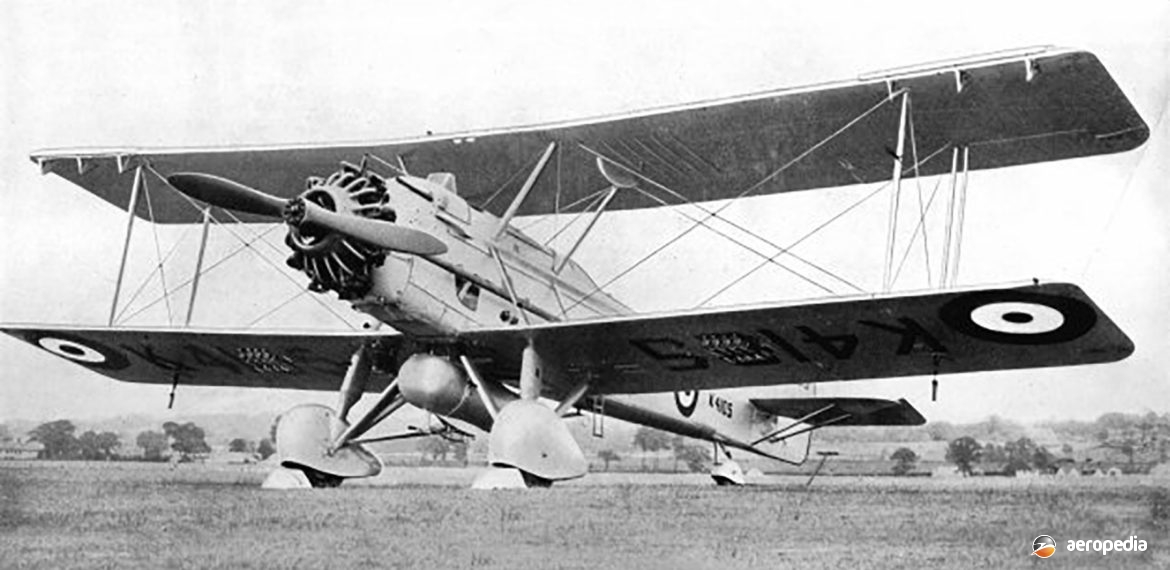Photograph:
Vickers Vincent K4105 (Eddie Coates Collection)
Country of origin:
United Kingdom
Description:
General purpose reconnaissance bomber
Power Plant:
One 492 kw (660 hp) Bristol Pegasus IIM3 nine-cylinder air-cooled radial engine
Specifications:
- Wingspan: 14.93 m (49 ft)
- Length: 11.21 m (36 ft 8 in)
- Height: 5.45 m (17 ft 9 in)
- Wing area: 67.63 m² (728 sq ft)
- Max speed at 1,500 m (4,920 ft): 229 km/h (142 mph)
- Initial rate of climb: 233 m/min (765 ft/min)
- Service ceiling: 5,791 m (19,000 ft)
- Normal range: 1,006 km (625 miles)
- Max range with long-range tank: 2,012 km (1,250 miles)
- Empty weight: 1,918 kg (4,229 lb)
- Loaded weight: 3,674 kg (8,100 lb)
Armament:
One 7.7 mm (0.303 in) Vickers machine gun fixed and firing forward; one 7.7 mm (0.303 in) Lewis machine gun mounted in rear cockpit; max bomb load 454 kg (1,000 lb)
History:
The Vincent was designed in 1934 by Vickers (Aviation) Ltd of Weybridge in Surrey as a modified variant of the Vildebeest to replace the Westland Wapiti and Fairey IIIF in RAF service. Basically similar to the Vildebeest, it had a long-range fuel tank under the fuselage in place of the torpedo, this increasing range to 2,012 km (1,250 miles). The prototype was placed on the UK civil register as G-ABGE for the 1930 Paris Airshow and it later became the Mk VII. Fitted with floats and a 444 kw (595 hp) Hispano Suiza 12Lbr engine, it made a tour of the Baltic countries. A total of 25 was built under licence in Spain by CASA and these flew in Republican service. One Mk XI was built and fitted with a 492 kw (660 hp) Bristol Pegasus IIIM3 engine and, registered G-ACYV, was used as a company demonstrator until it was scrapped in 1938.
Production of the Vincent commenced in 1934. A total of 171 Vincents was built as new aircraft, a further 26 (K4105 to K4130) being Vildebeest conversions, making a total of 197. They saw service with eight RAF squadrons and flights in India, Egypt, Iraq, East Africa and the Sudan. Eighty were still in service at the outbreak of World War II. In 1941 they were used when fighting broke out between British forces and Arabs in Iraq.
The Vincent was of similar construction to the Vildebeest and had a pick-up hook which enabled them to pick up messages when operating in the army co-operation role. They had special equipment to enable them to operate in dry and hot climates, such as in Iraq. The first production machine was a converted Vildebeest II (K4105) and it was first shown to the public at the 1935 Hendon Display in Greater London. The type was important in RAF service until the arrival of the Vickers Wellesley and Bristol Blenheim, some surviving in service with No 244 Squadron RAF in Iraq until 1941.
In mid 1939 sixteen Vincents were shipped to New Zealand, were taken on charge, and equipped the Auckland Territorial Squadron at Hobsonville. Later, a further two shipments were received making a total of 60 aircraft. It seems a number operated in New Zealand with their RAF serials. Examples served with the General Reconnaissance Squadron at Whenuapai but in New Zealand service did not carry a torpedo and, although the type carried the long-range fuel tank, this was not required in service. Like the Vildebeest, they were camouflaged in green and dark earth upper surfaces with sky blue lower surfaces, the paint being imported from Australia. Units equipped included No 2 Squadron, with which it served as a patrol bomber, No 7 at Waipapakauri, No 30 at Gisborne, and No 3 from Harewood. Examples were also attached to No 2 SFTS.
In the event Serials NZ300 to NZ361 were allotted to the Vincent, two (NZ300 and NZ361) being assembled from wrecks and spare parts. They also saw service with General Reconnaissance squadrons until replaced by Lockheed Hudsons, Lockheed Venturas etc. A few saw some service in the target towing role and these were fitted with a target towing winch on the port side of the gunner’s cockpit. These were painted overall yellow and black. By 1943 airframe corrosion and the breaking up of the fabric caused the type’s retirement, the last being broken up at Ohakea in 1944.
One Vincent survives. This aircraft operated with the RNZAF as NZ311 and had previously served with the Royal Air Force as K6357 with No 55 Squadron in Iraq before being shipped aboard the SS Gamaria to Auckland, arriving on 17 July 1939. It was assembled at No 1 Aircraft Depot and initially saw service at Hobsonville, being used for air-gunnery work, and at the Air Observation School at Ohakea from December 1939. In January 1940 it went to No 22 Army Co-operation Squadron at Ohakea where it operated in late 1942. It was then operated by No 1 Operational Training Unit for drogue towing but was broken up due to airframe deterioration in 1944. It was dumped north of Ohakea and remained there until recovered in 1972.
This aircraft, along with a Blackburn Baffin, are in the hands of the Subritzky family at North Shore, out of Auckland, in New Zealand where they are being slowly restored for static display and for eventual placement in an aviation museum.

